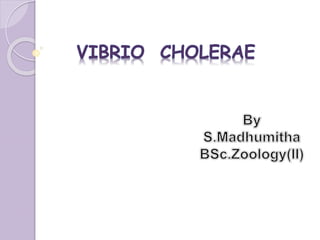
Vibrio cholerae
- 2. Domain : Bacteria Phylum : Proteobacteria Class : Gammaproteobacteria Order : Vibrionales Family : Vibrionaceae Genus : Vibrio Species : V.cholerae Fig.1: V.cholerae
- 3. Characterisitcs 1. V.cholerae is a Gram-negative, comma-shaped bacterium. The bacterium's natural habitat is brackish or saltwater where they attach themselves easily to the chitin-containing shells of crabs, shrimps, and other shellfish. 2.Some strains of V.cholerae cause the disease cholera, which can be derived from the consumption of undercooked or raw marine life species. V.cholerae is a facultative anaerobe and has a flagellum at one cell pole as well as pili. 3. V.cholerae can undergo respiratory and fermentative metabolism. When ingested, V.cholerae can cause diarrhea and vomiting in a host within several hours to 2–3 days of ingestion. V.cholerae is a highly motile and halophilic. Initial isolates are slightly curved, whereas they can appear as straight rods upon laboratory culturing. 4.The Vibrios tolerate alkaline media that kill most intestinal commensals, but they are sensitive to acid. It measures 0.3 micron in diameter and 1.3 micron in length with average swimming velocity of around 75.4 +/- 9.4 microns/sec.
- 4. Fig.1.1: Structure of Vibrio Cholerae
- 5. History 1.V.cholerae was first isolated as the cause of Cholera in 1854 by Italian anatomist Filippo Pacini and by the Catalan Joaquim Balcells i Pascual in the same year, but their discovery was not widely known until Robert Koch, working independently 30 years later, publicized the knowledge and the means of fighting the disease. 2.Pacini published a paper in 1854 entitled, “Microscopical observations and pathological deductions on cholera” in which he described the organism and its relation to the disease. His microscopic slides of the organism were clearly labeled, identifying the date and nature of his investigations. Fig.2.1: This microscope slide, prepared By Pacini in 1854, was clearly Fig.2.2: Fillippo Pacini identified as containing the cholera bacterium.
- 6. Pathogenesis 1. Vibrio cholerae is the causative agent of the diarrheal disease Cholera. 2.The disease is characterized by sudden effortless vomiting, profuse rice water stool followed by rapid dehydration. 3.Incubation occurs in human via oral route by ingestion of contaminated food or water. 4.Incubation period is 6 hours to 3 days. 5.The ingested micro organism reaches to the stomach and the multiplication occurs in the small intestine. 6.After the growth and multiplication it starts to produce toxins namely, “Cholera toxin” or “Cholera enterotoxin” or “Choleragen”
- 7. 7.This toxins cause the of Hyper secretion of glands in the intestine and resulting in large amount of intestinal fluids in the intestinal lumens. 8.The toxin also increases the capillary permeability leading to edema. 9.On the same hand it produces proteolytic enzymes, which help the organism to penetrate the covering of GI tract and causes the diarrheal disease among humans. 10.The stools are rice water similar which containing mucous, epithelial cells and large number of vibrios. 11.The massive loss of electrolytes from the body leads to metabolic acidosis, muscle cramps, anuria, acute tubular necrosis, shock and some times death. 12.This disease may last for 4-5 days with an average fluid loss of 15-20 liters per day.
- 8. Fig.3: Mechanism of the Cholera Toxin.
- 9. Cultural Characteristics 1. Vibrio is aerobic, growth being scanty and slow anaerobically 2.Temp range 16-40 degree Celsius (optimum 37oC) 3.Growth better in alkaline medium, pH range 6.4-9.6 (optimum 8.2) 4. NaCl (0.5-1%) is required for optimal growth though high concentration (6% and above) are inhibitory halotolerant. 5.Vibrios while halophilic vibrios like parahaemolyticus needs a higher concentration of NaCl 6.Grows well in ordinary culture media 1. Nutrient Agar medium: Overnight growth colonies are moist, translucent, round discs about 1-2 mm in diameter, with a bluish tinge in transmitted light. 2. Macconkey Agar medium: Colorless at first but become reddish on prolonged incubation due to late lactose fermentation 3.Blood Agar medium: Colonies are surrounded by the zone of greening, later becomes clear due to hemodigestion.
- 10. 7.In gelatin stab culture, infundibuliform (funnelshaped) or napiform (turnip-shaped) liquefaction occurs in 3 days at 22oC 8.Peptone water: Growth occurs in six hours as a fine surface pellicle, which on shaking breaks down into membranous pieces. Turbidity and a powdery deposit develop on continued incubation. Special Media Holding or transport media: 1.Modified form of VR medium: 1 ml of stool is added to each bottle.Vibrio remain viable for several weeks 2.Cary Blair medium 3.Autoclaved Seawater Enrichment Media: Alkaline Peptone Water (Transport as well as enrichment media) TCBA Media: In this medium large colonies will be formed in yellow color. Later the yellow color will be changed to green color.
- 11. Fig.4.1: Blood Agar medium Fig.4.2: TCBS cholera medium
- 12. THANK YOU